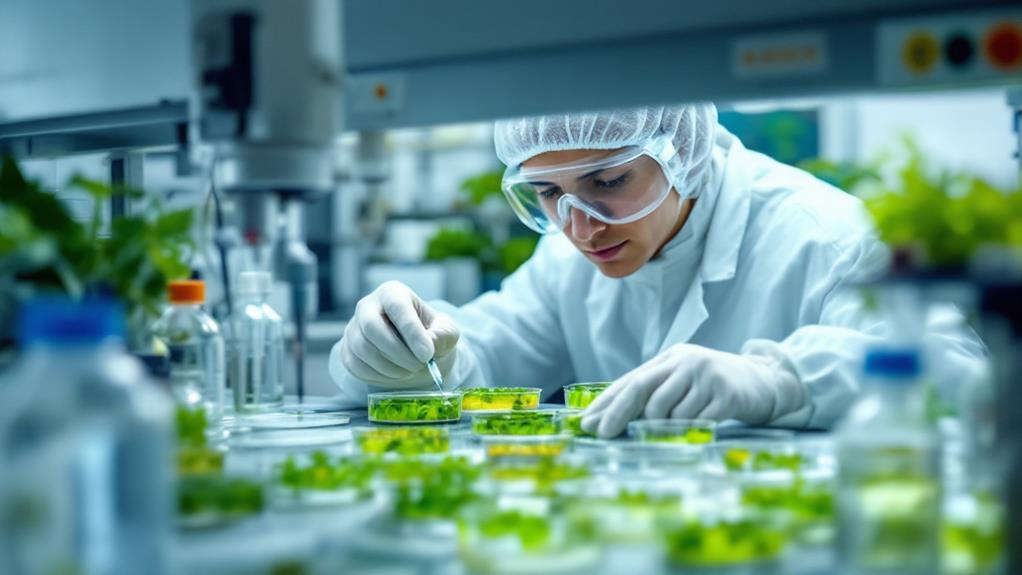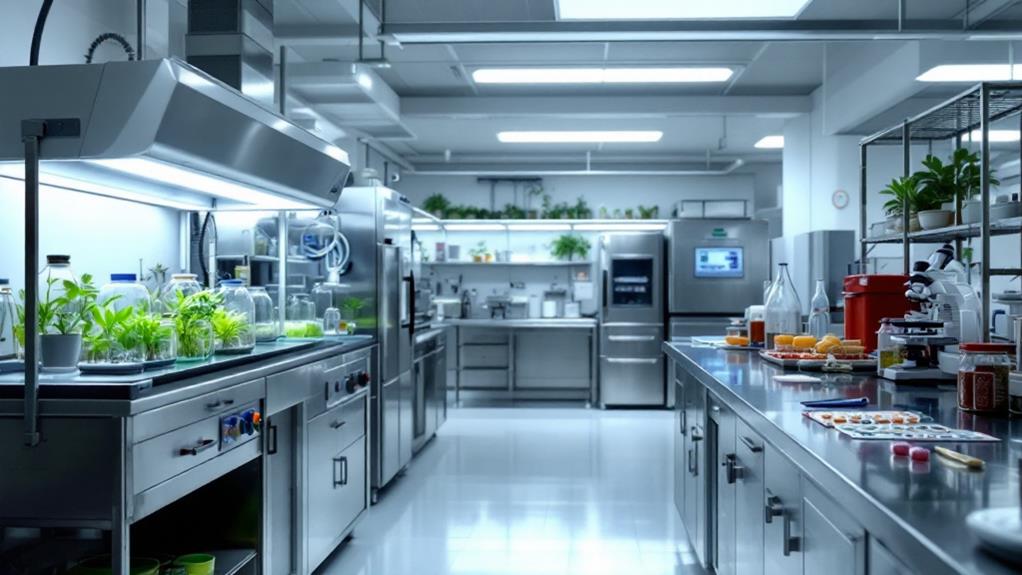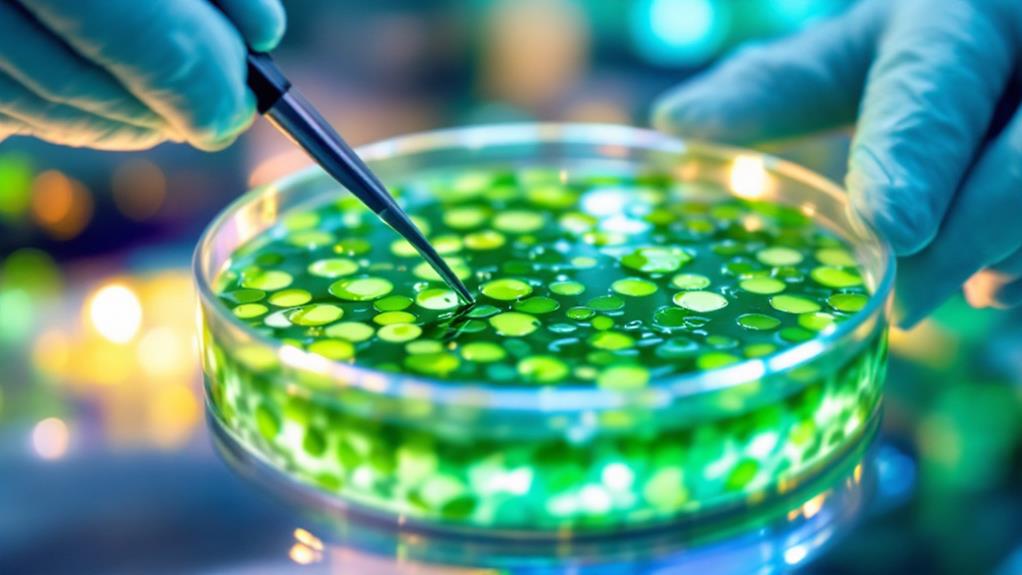Plant tissue culture is a technique where you grow plant cells, tissues, or organs in sterile conditions on artificial nutrient media. It’s widely used in agriculture for crop improvement, mass propagation, and producing disease-free plants. You’ll find it essential for creating new plant varieties with desirable traits and conserving rare species. The process involves selecting an explant, sterilizing it, and placing it on a nutrient-rich medium under controlled environmental conditions. While it offers rapid propagation and genetic manipulation benefits, it requires specialized equipment and skilled labor. Exploring further will reveal the transformative potential of this biotechnology in addressing global agricultural challenges.
Fundamentals of Plant Tissue Culture
Plant tissue culture is a fundamental technique in plant biotechnology. It involves growing plant cells, tissues, or organs in sterile conditions on artificial nutrient media. You’ll find this method vital for various applications, including rapid plant propagation, crop enhancement, and production of secondary metabolites.
To start a plant tissue culture, you’ll need to select an explant, which is a small piece of plant material. This could be a leaf segment, stem cutting, or even a single cell. You’ll then sterilize the explant to remove any contaminants before placing it on a nutrient medium.
The culture medium is essential for success. It contains necessary nutrients, vitamins, plant hormones, and a carbon source. You’ll need to adjust the medium’s composition based on the plant species and your specific goals. For example, you might use different hormone ratios to promote shoot or root development.
Environmental factors play a significant role in tissue culture. You’ll need to control temperature, light, and humidity to create ideal growing conditions. Most cultures are kept in growth chambers or rooms with controlled environments.
As the explant grows, you’ll observe different stages of development. These may include callus formation, shoot initiation, root development, and plantlet formation. You can manipulate these stages by altering the culture conditions or transferring the tissues to new media.
It’s important to maintain aseptic techniques throughout the process. Any contamination can quickly ruin your cultures. You’ll need to work in a laminar flow hood and use sterile instruments and containers.
Applications in Agriculture
Transforming agricultural practices, plant tissue culture techniques have found numerous applications in modern farming. You’ll find these methods particularly useful in crop improvement, mass propagation, and disease management.
In crop improvement, you can use tissue culture to create new plant varieties with desirable traits. Through techniques like somaclonal variation and protoplast fusion, you’re able to develop plants with improved yield, resistance to pests and diseases, or enhanced nutritional value. You can also use embryo rescue to overcome breeding barriers between distantly related species, expanding the genetic pool for crop improvement.
Mass propagation is another significant application. You can produce large numbers of genetically identical plants rapidly through micropropagation. This technique is especially valuable for crops that are difficult to propagate conventionally, such as orchids or banana. It also allows you to maintain clonal fidelity, ensuring consistent quality in your crops.
Disease management benefits greatly from tissue culture. You can produce disease-free plants through meristem culture, eliminating viruses and other pathogens. This technique is essential in the production of healthy planting material for crops like potato, strawberry, and cassava.
Germplasm conservation is another important application. You can preserve rare or endangered plant species using in vitro storage techniques. This helps maintain biodiversity and provides a valuable resource for future breeding programs.
Lastly, you can use tissue culture for the production of secondary metabolites. This allows you to produce valuable compounds like pharmaceuticals or fragrances in a controlled environment, independent of environmental factors that might affect field-grown plants.
Techniques and Methodologies

Various techniques and methodologies form the backbone of plant tissue culture. You’ll find that these methods are vital for successful cultivation and propagation of plant cells, tissues, and organs in controlled environments.
One of the primary techniques you’ll encounter is micropropagation. This method involves producing genetically identical plants through the use of tissue culture. You’ll start by selecting a small piece of plant tissue, called an explant, and placing it in a sterile culture medium. The explant will then develop into a mass of undifferentiated cells, known as callus, or directly into small plantlets.
Another important methodology is somatic embryogenesis. In this process, you’ll induce the formation of embryo-like structures from somatic cells. These embryos can then be germinated to produce whole plants. This technique is particularly useful for mass propagation of elite plant varieties.
Protoplast culture is a more advanced method you might employ. It involves removing the cell wall from plant cells, leaving only the protoplast. You can then manipulate these protoplasts for various purposes, such as genetic modification or cell fusion.
Anther and microspore culture are techniques you’ll use for haploid plant production. By culturing anthers or isolated microspores, you can produce plants with only one set of chromosomes, which is valuable for breeding programs and genetic studies.
Lastly, you’ll find cryopreservation to be essential for long-term storage of plant genetic resources. This method involves freezing plant tissues in liquid nitrogen, allowing you to preserve valuable germplasm for future use.
Advantages and Limitations
When considering plant tissue culture, you’ll find it comes with a range of advantages and limitations. On the positive side, this technique allows you to rapidly propagate plants, producing large numbers of genetically identical clones in a short time. You’ll also appreciate its ability to conserve rare or endangered species, as you can maintain viable plant material in controlled conditions. Plant tissue culture enables you to produce disease-free plants, eliminating pathogens that might be present in traditional propagation methods.
You’ll find that this method is particularly useful for creating transgenic plants, as it allows for easier genetic manipulation. It’s also valuable for producing secondary metabolites used in pharmaceuticals and cosmetics. Additionally, you can use tissue culture to overcome seasonal limitations, producing plants year-round in controlled environments.
However, you should be aware of the limitations. The process requires specialized equipment and sterile conditions, which can be costly to maintain. You’ll need skilled technicians to perform the procedures accurately. Some plants are recalcitrant to tissue culture, making it difficult or impossible to propagate them using this method. There’s also a risk of genetic instability in cultured plants, potentially leading to somaclonal variations.
You might encounter issues with acclimatization when transferring plants from culture to soil. The technique can be time-consuming and labor-intensive, especially for large-scale production. Finally, you should consider that tissue culture-derived plants may be more susceptible to certain diseases due to their genetic uniformity, potentially increasing the risk of widespread crop losses in agricultural settings.
Equipment and Laboratory Setup

A well-equipped laboratory is vital for successful plant tissue culture. You’ll need several key pieces of equipment to create a sterile environment and maintain ideal growing conditions for your plant samples.
First, you’ll require a laminar flow hood, which provides a sterile workspace by filtering air and creating a barrier against contaminants. This is where you’ll perform most of your culture manipulations. You’ll also need an autoclave for sterilizing tools, media, and glassware.
Incubators or growth chambers are essential for maintaining the proper temperature, light, and humidity levels for your cultures. These can range from simple shelving units with fluorescent lights to sophisticated controlled-environment chambers.
You’ll need various glassware and containers, including test tubes, petri dishes, and culture flasks. Precision instruments like forceps, scalpels, and pipettes are vital for handling delicate plant tissues and measuring small quantities of media components.
A pH meter is necessary for adjusting the acidity of your culture media, while an analytical balance will help you measure ingredients accurately. You’ll also need a refrigerator and freezer for storing media, chemicals, and plant materials.
Don’t forget about personal protective equipment (PPE) such as lab coats, gloves, and safety glasses. These items are essential for maintaining a sterile environment and protecting yourself from potentially harmful chemicals.
Lastly, you’ll need a microscope for examining your cultures and identifying any signs of contamination or abnormal growth. With this equipment in place, you’ll be well-prepared to begin your plant tissue culture experiments.
Media Preparation and Sterilization
Before you can begin culturing plant tissues, you’ll need to prepare and sterilize the growth media. This vital step guarantees that your plant tissues have the necessary nutrients and a contamination-free environment to grow.
Start by selecting an appropriate basal medium, such as Murashige and Skoog (MS) or Gamborg’s B5. These media contain essential macro- and micronutrients, vitamins, and amino acids. You’ll need to adjust the pH of the medium to around 5.7-5.8 using either HCl or NaOH. Next, add plant growth regulators (PGRs) like auxins and cytokinins, which control cell division and differentiation. The specific PGRs and their concentrations will depend on your plant species and culture objectives.
For solid media, add a gelling agent like agar or gellan gum. Heat the mixture to dissolve the agar, then dispense it into sterilized containers. For liquid media, simply pour the solution into appropriate vessels. Both types of media must be sterilized to prevent contamination.
Use an autoclave to sterilize your prepared media. Typically, you’ll autoclave at 121°C and 15 psi for 15-20 minutes. Some heat-sensitive components, like certain vitamins or antibiotics, should be filter-sterilized and added after autoclaving. Always handle sterilized media in a laminar flow hood to maintain sterility.
Remember to label your media containers with the composition, preparation date, and your initials. Store prepared media in a cool, dark place and use it within a few weeks to guarantee ideal nutrient availability for your plant cultures.
Micropropagation Process
Through micropropagation, you can rapidly multiply plants in a controlled environment. This process involves several key stages that you’ll need to follow carefully to guarantee success. First, you’ll select and prepare the mother plant, choosing a healthy specimen free from diseases. You’ll then sterilize the plant material and isolate the desired explant, which could be a shoot tip, node, or leaf segment.
Next, you’ll initiate the culture by placing the explant on a nutrient-rich medium containing growth regulators. You’ll need to maintain sterile conditions throughout this stage to prevent contamination. Once the explant begins to grow, you’ll move on to the multiplication phase. Here, you’ll transfer the developing shoots to a fresh medium that promotes rapid proliferation. You’ll repeat this process several times to increase the number of plantlets.
When you’ve achieved the desired quantity, you’ll start the elongation and rooting phase. You’ll transfer the shoots to a medium that encourages root development and overall plant growth. As the plantlets develop roots and reach an appropriate size, you’ll begin the acclimatization process. This involves gradually exposing the plants to lower humidity and higher light levels to prepare them for ex vitro conditions.
Genetic Modification Through Tissue Culture
Plant tissue culture techniques don’t just allow for rapid multiplication; they also open up possibilities for genetic modification. You can use these methods to introduce new genes or alter existing ones in plant cells, creating plants with desired traits or improved characteristics.
One common approach is Agrobacterium-mediated transformation. You’ll use this soil bacterium‘s natural ability to transfer DNA to plant cells. By modifying the bacterium’s plasmid to carry your desired genes, you can introduce them into plant tissue cultures. The transformed cells will then integrate the new genetic material into their genome.
Another method you might employ is particle bombardment, also known as biolistics. In this technique, you’ll coat tiny gold or tungsten particles with DNA and shoot them into plant cells using a gene gun. Some of these particles will penetrate the cell walls and nuclei, allowing the DNA to be incorporated into the plant’s genome.
You can also use electroporation to introduce genes into protoplasts (plant cells without cell walls). By applying an electric field, you’ll create temporary pores in the cell membrane, allowing DNA to enter the cell.
Once you’ve introduced the new genes, you’ll need to select and regenerate the transformed cells. You’ll typically use selective media containing antibiotics or herbicides to identify successfully transformed cells. These cells can then be cultured and regenerated into whole plants carrying the desired genetic modifications.
Through these techniques, you can develop plants with improved traits such as disease resistance, increased yield, or enhanced nutritional content, contributing to advancements in agriculture and biotechnology.
Commercial Applications and Industry Impact
The plant tissue culture industry has revolutionized commercial horticulture and agriculture. You’ll find its impact across various sectors, from ornamental plant production to crop improvement and conservation efforts.
In the ornamental plant industry, tissue culture has enabled mass production of high-quality, disease-free plants. You can now purchase genetically identical orchids, ferns, and other exotic species at a fraction of their previous cost. This technique has also made it possible to propagate plants that are difficult to grow from seeds or cuttings.
For agriculture, tissue culture has become an essential tool in crop improvement. You’ll see its application in developing disease-resistant varieties, creating hybrid plants, and producing virus-free stock. It’s particularly valuable for crops like bananas, potatoes, and strawberries, where traditional breeding methods are challenging.
The pharmaceutical industry has benefited from plant tissue culture as well. You can now produce valuable plant-derived compounds in controlled laboratory conditions, ensuring consistent quality and reducing reliance on wild harvesting.
Conservation efforts have also been bolstered by tissue culture. You can use it to propagate endangered plant species and preserve genetic diversity. This technique has proven invaluable in saving plants on the brink of extinction.
Economically, the plant tissue culture market continues to grow. You’ll find it’s projected to reach billions of dollars in the coming years, driven by increasing demand for high-quality planting material and the need for sustainable agricultural practices.
Future Prospects and Challenges
Surely, plant tissue culture technology will continue to evolve and expand its applications in the coming years. You’ll see advancements in genetic engineering techniques, allowing for more precise modifications of plant genomes. This will lead to the development of crops with enhanced traits, such as improved nutritional content, disease resistance, and environmental adaptability.
Another promising area is the use of plant tissue culture in conservation efforts. You’ll witness increased efforts to preserve endangered plant species through in vitro propagation and cryopreservation. This will help maintain biodiversity and protect vulnerable ecosystems.
However, you’ll also face challenges in the field. One major hurdle is the high cost of equipment and skilled labor required for plant tissue culture. You’ll need to develop more cost-effective methods to make this technology accessible to a wider range of researchers and industries.
You’ll also encounter issues with genetic stability in cultured plants. As you scale up production, maintaining genetic fidelity becomes vital. You’ll need to refine techniques to minimize somaclonal variation and guarantee consistent quality in tissue-cultured plants.
Regulatory concerns will continue to be a challenge, especially for genetically modified plants. You’ll need to navigate complex approval processes and address public concerns about the safety and environmental impact of these technologies.
Lastly, you’ll face the challenge of adapting plant tissue culture techniques to a wider range of species. Many economically important plants remain recalcitrant to in vitro propagation, limiting the technology’s applications. You’ll need to develop species-specific protocols to overcome these limitations and expand the scope of plant tissue culture.

Erzsebet Frey (Eli Frey) is an ecologist and online entrepreneur with a Master of Science in Ecology from the University of Belgrade. Originally from Serbia, she has lived in Sri Lanka since 2017. Eli has worked internationally in countries like Oman, Brazil, Germany, and Sri Lanka. In 2018, she expanded into SEO and blogging, completing courses from UC Davis and Edinburgh. Eli has founded multiple websites focused on biology, ecology, environmental science, sustainable and simple living, and outdoor activities. She enjoys creating nature and simple living videos on YouTube and participates in speleology, diving, and hiking.

